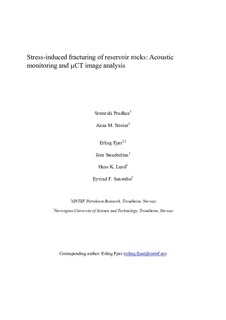| dc.contributor.author | Pradhan, Srutarshi | |
| dc.contributor.author | Stroisz, Anna Magdalena | |
| dc.contributor.author | Fjær, Erling | |
| dc.contributor.author | Stenebråten, Jørn | |
| dc.contributor.author | Lund, Hans Karl | |
| dc.contributor.author | Sønstebø, Eyvind Frode | |
| dc.date.accessioned | 2018-01-29T10:18:59Z | |
| dc.date.available | 2018-01-29T10:18:59Z | |
| dc.date.created | 2015-11-19T12:34:02Z | |
| dc.date.issued | 2015 | |
| dc.identifier.citation | Rock Mechanics and Rock Engineering. 2015, 48 (6), 2529-2540. | nb_NO |
| dc.identifier.issn | 0723-2632 | |
| dc.identifier.uri | http://hdl.handle.net/11250/2480212 | |
| dc.description.abstract | Stress-induced fracturing in reservoir rocks is an important issue for the petroleum industry. While productivity can be enhanced by a controlled fracturing operation, it can trigger borehole instability problems by reactivating existing fractures/faults in a reservoir. However, safe fracturing can improve the quality of operations during CO2 storage, geothermal installation and gas production at and from the reservoir rocks. Therefore, understanding the fracturing behavior of different types of reservoir rocks is a basic need for planning field operations toward these activities. In our study, stress-induced fracturing of rock samples has been monitored by acoustic emission (AE) and post-experiment computer tomography (CT) scans. We have used hollow cylinder cores of sandstones and chalks, which are representatives of reservoir rocks. The fracture-triggering stress has been measured for different rocks and compared with theoretical estimates. The population of AE events shows the location of main fracture arms which is in a good agreement with post-test CT image analysis, and the fracture patterns inside the samples are visualized through 3D image reconstructions. The amplitudes and energies of acoustic events clearly indicate initiation and propagation of the main fractures. Time evolution of the radial strain measured in the fracturing tests will later be compared to model predictions of fracture size. | nb_NO |
| dc.language.iso | eng | nb_NO |
| dc.publisher | Springer Verlag | nb_NO |
| dc.title | Stress-Induced Fracturing of Reservoir Rocks: Acoustic monitoring and uCT Image Analysis | nb_NO |
| dc.type | Journal article | nb_NO |
| dc.description.version | submittedVersion | nb_NO |
| dc.source.pagenumber | 2529-2540 | nb_NO |
| dc.source.volume | 48 | nb_NO |
| dc.source.journal | Rock Mechanics and Rock Engineering | nb_NO |
| dc.source.issue | 6 | nb_NO |
| dc.identifier.doi | 10.1007/s00603-015-0853-4 | |
| dc.identifier.cristin | 1290928 | |
| dc.relation.project | Norges forskningsråd: 194070 | nb_NO |
| dc.relation.project | Norges forskningsråd: 217413 | nb_NO |
| dc.relation.project | Norges forskningsråd: 199970 | nb_NO |
| dc.description.localcode | This is a pre-print of an article published in [Rock Mechanics and Rock Engineering]. The final authenticated version is available online at: https://link.springer.com/article/10.1007%2Fs00603-015-0853-4 | nb_NO |
| cristin.unitcode | 194,64,90,0 | |
| cristin.unitname | Institutt for geovitenskap og petroleum | |
| cristin.ispublished | true | |
| cristin.fulltext | preprint | |
| cristin.qualitycode | 2 | |
